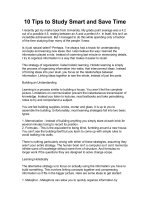telling time
Bạn đang xem bản rút gọn của tài liệu. Xem và tải ngay bản đầy đủ của tài liệu tại đây (5.1 MB, 36 trang )
Telling Time
MURPHY
2
$14.99
USA
$17.99
Canada
DK READERS
With DK READERS, children
will learn to readÑthen read to learn!
Discover more at
www.dk.com
Stunning photographs combine
with lively illustrations and engaging,
age-appropriate stories in
DK READERS
, a multilevel
reading program guaranteed to capture children’s interest
while developing their reading skills and general knowledge.
DK READERS
READERS
READERS
I S B N 978-0-75 66-2949-6
9 7 8 0 7 5 6 6 2 9 4 9 6
5 1 4 9 9
Discover how humans have told
time over the ages, from
sundials to modern clocks.
Jacket images Front: DK Images:
National Maritime Museum, London cla;
Stephen Oliver bl; The Science Museum, London cb.
Telling Time
PATRICIA J.
MURPHY
Proficient
readers
Reading
alone
Beginning
to read alone
Beginning
to read
Learning
to read
•
High-frequency words
•
Picture word strips, picture glossary, and simple index
•
Labels to introduce and reinforce
vocabulary
•
High level of adult participation helpful
•
Longer sentences and increased vocabulary
•
Information boxes full of extra fun facts
•
Simple index
•
Occasional adult participation helpful
•
More complex sentence structure
•
Information boxes and alphabetical glossary
•
Comprehensive index
•
Simple sentences and limited vocabulary
•
Picture glossary
and simple index
•
Adult participation helpful
•
Rich vocabulary and challenging sentence structure
•
Additional information and alphabetical glossary
•
Comprehensive index
Printed in China
.
A Note to Parents
DK READERS is a compelling program for beginning
readers, designed in conjunction with leading literacy
experts, including Dr. Linda Gambrell, Professor of
Education at Clemson University. Dr. Gambrell has
served as President of the National Reading Conference
and the College Reading Association, and has recently
been elected to serve as President of the International
Reading Association.
Beautiful illustrations and superb full-color
photographs combine with engaging, easy-to-read stories
to offer a fresh approach to each subject in the series.
Each DK READER is guaranteed to capture a child’s
interest while developing his or her reading skills,
general knowledge, and love of reading.
The ve levels of DK READERS are aimed at different
reading abilities, enabling you to choose the books that
are exactly right for your child:
Pre-level 1: Learning to read
Level 1: Beginning to read
Level 2: Beginning to read alone
Level 3: Reading alone
Level 4: Procient readers
The “normal” age at which a child
begins to read can be anywhere from
three to eight years old. Adult
participation through the lower
levels is very helpful for providing
encouragement, discussing storylines,
and sounding out unfamiliar words.
No matter which level you select, you
can be sure that you are helping your
child learn to read, then read to learn!
Series Editor Deborah Lock
Art Editor Sadie Thomas
U.S. Editor John Searcy
DTP Designer Ben Hung
Production Georgina Hayworth
Picture Researcher Rob Nunn
Illustrator Peter Dennis
Reading Consultant
Linda Gambrell, Ph.D.
First American Edition, 2007
07 08 09 10 11 10 9 8 7 6 5 4 3 2 1
Published in the United States by DK Publishing
375 Hudson Street, New York, New York 10014
Copyright © 2007 Dorling Kindersley Limited
All rights reserved under International and Pan-American
Copyright Conventions. No part of this publication may be
reproduced, stored in a retrieval system, or transmitted in any
form or by any means, electronic, mechanical, photocopying,
recording, or otherwise, without the prior written permission
of the copyright owner.
Published in Great Britain by Dorling Kindersley Limited
DK books are available at special discounts when purchased in bulk for
sales promotions, premiums, fund-raising, or educational use.
For details, contact:
DK Publishing Special Markets
375 Hudson Street
New York, New York 10014
A catalog record for this book is available
from the Library of Congress
ISBN: 978-0-7566-2948-9 (Paperback)
ISBN: 978-0-7566-2949-6 (Hardcover)
Color reproduction by Colourscan, Singapore
Printed and bound in China by L. Rex Printing Co. Ltd.
The publisher would like to thank the following for their kind
permission to reproduce their photographs.
a=above, b=below, c=center, l=left, r=right, t=top.
Alamy Images: A Room With Views 6-7; Richard Levine 48br.
The Bridgeman Art Library: The Makins Collection 24. Corbis:
22br; Bettmann 26; Grace/zefa 4b. Hulton-Deutsch Collection
19tr; Wolfgang Kaehler 14; Markus Moellenberg/zefa 29t; Carl &
Ann Purcell 21bl; Tim Thompson 3cb, 20r; Holger Winkler/zefa
5c. DK Images: NASA 28bl, 28cb; National Maritime Museum,
London 2tr, 19tl; Natural History Museum, London 25tr; Stephen
Oliver 15tl, 30cr, 49br; The Science Museum, London 15tr, 18crb.
National Institute of Standards and Technology / NIST: Geoffrey
Wheeler Photography 28tr. Science & Society Picture Library:
Science Museum 13cr, 13cra, 13tr. Science Photo Library: 16tl.
SuperStock: Maria Ferrari 16-17.
All other images © Dorling Kindersley Limited
For more information see: www.dkimages.com
LONDON, NEW YORK, MUNICH,
MELBOURNE, and DELHI
Discover more at
www.dk.com
Written by Patricia J. Murphy
Telling Time
DK Publishing
R
E
A
D
E
R
S
P
R
O
F
I
C
I
E
N
T
A
L
O
N
E
R
E
A
D
I
N
G
T
O
R
E
A
D
B
E
G
I
N
N
I
N
G
T
O
R
E
A
D
A
L
O
N
E
B
E
G
I
N
N
I
N
G
2
3
1
4
READERS
Do you know what time it is?
We tell time many times a day.
When is soccer
practice?
We use clocks to tell time.
They help people plan their day.
People have been telling time
for a long, long time.
What time is dinner?
When does
the party start?
What time will
you get there?
Clocks from long ago did not look
like ours and they did not keep
the best time either.
This is the story of how clocks
have changed.
Prehistoric times
Timeline
Once upon a time, people woke up
when the sun rose and went to bed
when the moon and stars came out.
These were the first clocks.
Sometimes, people used stone pillars
to mark the movement of the sun,
moon, and stars during the year.
Stonehenge
in England
Timeline
More than 5,500 years
ago, ancient Egyptians
watched shadows
to tell time.
They placed sticks
called gnomons
[NO-muns]
in the ground.
They also built
stone pillars
called
obelisks.
Obelisk
3500 BCE
8
Prehistoric times
These sticks and obelisks cast
long shadows on the ground.
As the sun moved, the direction
of the shadows told people
what part of the day it was.
These devices were
the very first sundials.
9
In 1500 BCE,
the Egyptians built
an even better
sundial.
1500 BCE
10
Prehistoric times
Timeline
3500 BCE
Time for bed, Tut!
Around 600 BCE,
Egyptians lined up
merkhets [MER-kets]
with the stars to tell
the time at night.
It was shaped like a T and
had special markings.
The marks split the day into
ten hours of daylight and
two hours of twilight.
Like all sundials, this one could
only tell time in sunlight.
People could not tell what time
it was on cloudy days or at night.
11
. .
Prehistoric times
Timeline
3500 BCE
1500 BCE
1400 BCE
Starting in 1400 BCE,
ancient Egyptians
and Greeks used
water clocks to tell
time during the day
and the night.
12
.
Water-clock tower
In 1088, Su Sung, a Chinese
monk, built an amazing
water-clock tower. It was
more than 30 feet (9 m) tall
and had many moving parts.
Water was poured into
a bowl with holes in it.
As the water dripped
out through
the holes, people
checked the water levels
using special marks.
This told them how much
time had passed.
Water-level
marks
13
Prehistoric times
Timeline
3500 BCE
1500 BCE
1400 BCE
Seven hundred years ago,
big and heavy
weight-driven clocks
were invented.
Many of these clocks
had round faces and
moving hands.
After the weights
were raised up,
they would lower
slowly to make
the clocks work.
Bells on this clock tower
rang on the hour.
14
1300
Two hundred years later, clocks
were made that were powered by
springs instead of weights.
They were small and light, and
some were made to fit in pockets.
These tiny timepieces were
the first pocket watches.
The outside
and inside of
a pocket
watch
15
1500
In 1582, Galileo
Galilei noticed
that an oil lamp
swinging from
a chain kept perfect time.
He found that
a swinging weight
always took the same
number of beats
to go backward
and forward.
16
Timeline
Prehistoric times
3500 BCE
1500 BCE
1400 BCE
1300
Another name for a swinging
weight is a pendulum.
In 1657, Christiaan Huygens
invented a clock that used
a pendulum to keep time.
17
The cuckoo clock
This pendulum clock makes
a whistle that sounds like
a cuckoo bird every hour.
If it is 12 o’clock, it whistles
12 times!
pendulum
1500
1657
Prehistoric times
Timeline
3500 BCE
1500 BCE
1400 BCE
1300
On the high seas, sailors needed
to know the exact time to find
their way.
Pendulum clocks
needed to stand
still and would
not work on
choppy waters.
18
Sands of time
Sometimes, sailors used hourglasses
filled with sand or powdered
eggshells to tell time. The powder
would take one hour to flow from
the top bulb to the bottom bulb.
1500
1657
In 1759, John Harrison invented
the H4 chronometer, a special clock
to use on ships.
It worked so well that it won
a prize from the British government.
19
John Harrison
H4 chronometer
1759
Clocks had problems on land, too.
Each town set its clocks
using the sun.
When the sun reached
the highest place in
the sky, it was 12 noon
for that town.
20
Prehistoric times
Timeline
3500 BCE
1500 BCE
1400 BCE
1300
21
Since the sun reaches the highest
place in the sky at different times
in different places, every town
had its own 12 noon!
Time was different
all over the place.
It was a mess!
1500
1657
1759
Many people thought it was silly
for every town to have its own time.
They asked questions like:
“How can railroads and
mail coaches run on time?”
“How can people meet for lunch
or do business?”
“How can we fix this problem?”
Sandford Fleming, a railroad
worker, knew the answer.
22
Prehistoric times
Timeline
3500 BCE
1500 BCE
1400 BCE
1300
Greenwich Mean Time
Greenwich Mean Time (GMT)
is the time in Greenwich,
England. Each time zone was
described by how many hours
away from GMT it was.
12:00 15:00 18:00 21:00 24:0001:00 03:00 06:00 09:00 12:00 15:00 18:00 21:00 24:0001:00 03:00 06:00 09:00
–11 +11+10+9+8+7+6+5+4+3+2+10–1
–12
+12
–10 –9 –8 –7 –6 –5 –4 –3 –2
+5.5
+4.5
+3.5
+6.5
+9.5
+1
+1
+2
+3
+2
+2
+3
+5
+6
+7
+8
+9
+8
+10
+10
+11
+12
0
-3
-4
-5-6
-7
-8
-9
-5
-3
-4
His idea was to divide
the world into 24 time zones.
Each zone was exactly one hour
apart from its neighbors.
Now, time was the same for
everyone in each zone.
23
1500
1657
1759
1884
Prime Meridian
International Date Line
International Date Line
Anchorage
Rio de Janeiro
London
Nairobi
Tokyo
London
Rio de Janeiro
Nairobi
Tokyo
Anchorage
A map of the
world’s time zones









